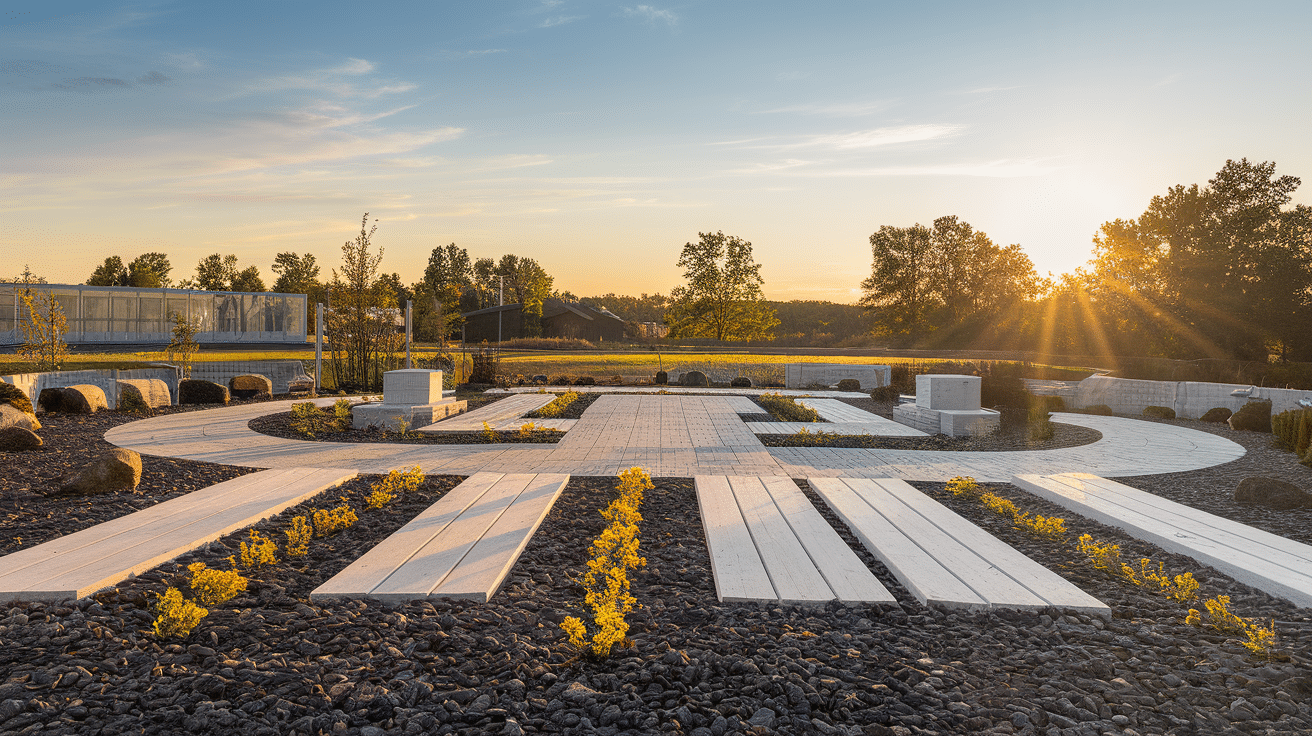Imagine trying to paint a masterpiece without first considering the canvas. That’s architecture without site planning.
This crucial first dance between vision and reality transforms raw land into architectural possibility.
While floor plans map interior journeys, site plans reveal how structures embrace their surroundings, where sunlight will warm morning coffee spots, how rainwater will flow, and where visitors will first experience your creation.
For visionaries and builders alike, masterful site planning transforms ordinary projects into extraordinary places.
It’s the hidden choreography that makes buildings appear perfectly at home in their environment as if they couldn’t possibly exist anywhere else.
Essential Elements of an Architectural Site Plan
A comprehensive site plan serves as a detailed roadmap, containing far more than just the building footprint. At its core, every effective site plan includes:
- Project identification – Title block with project name, client information, and architect details
- Scale and orientation – North arrow and consistent scale representation
- Property boundaries – Legal lot lines and setbacks that define buildable areas
- Topographical features – Contour lines showing elevation changes across the site
- Existing elements – Trees, structures, and features that must be preserved or removed
- Proposed structures – Building footprints with dimensions and placement
- Access points – Driveways, walkways, and connections to public thoroughfares
- Utility connections – Water, sewer, electrical, and gas service locations
- Landscape details – Planting areas, retaining walls, and outdoor spaces
- Legal restrictions – Easements, rights-of-way, and zoning requirements
These components work together to create a holistic representation of how the project will integrate with its surroundings, guiding every subsequent decision in the design process.
Critical Factors Shaping Effective Site Planning
1. Natural Impacts
The physical characteristics of a site dictate numerous design decisions. Climate conditions, from prevailing winds to seasonal sun paths, influence building orientation and energy efficiency.
Geological factors determine foundation requirements, while topographical features like slopes and depressions affect drainage patterns and construction costs.
Existing vegetation provides opportunities for preservation, shade, and visual integration with the surrounding environment.
2. Cultural Context
Successful site planning respects a location’s historical and cultural significance. Properties near historic landmarks require careful consideration of visual impact and contextual appropriateness.
Indigenous cultural sites demand preservation and respectful integration. Understanding these elements ensures that new construction enhances rather than diminishes a place’s character.
3. Practical Considerations
Beyond aesthetics and context, site planning addresses functional requirements essential for daily use. Strategically placing access points ensures the safe and efficient movement of vehicles and pedestrians.
The thoughtful design of drainage systems prevents water damage and erosion. Sufficient parking accommodates users while minimizing environmental impact.
Utility placement optimizes connection efficiency while maintaining accessibility for future maintenance.
Site Plans Throughout the Building Process
Site planning influences the entire architectural journey. During conceptual phases, preliminary site plans help clients visualize possibilities and constraints.
For regulatory approval, detailed site plans demonstrate compliance with zoning ordinances, environmental regulations, and building codes.
During construction, contractors rely on site plans to properly position buildings, install utilities, and implement landscape features.
This continuity makes site planning documents among the most referenced throughout a project’s lifecycle.
From initial client presentations to final inspections, these drawings guide decision-making at every stage, preventing costly mistakes and ensuring cohesive implementation.
Directing Site Planning Challenges
Architects regularly encounter obstacles that test their site planning expertise. Irregular lot shapes require creative solutions to maximize usable space while maintaining aesthetic appeal.
Steep slopes demand innovative approaches to foundation design and erosion control.
Dense urban environments present challenges in accessing utilities and managing construction logistics.
Successful architects approach these challenges methodically. They begin with thorough site documentation, identifying both constraints and opportunities.
They engage with regulatory authorities early to understand requirements before finalizing designs.
They leverage technology to visualize potential solutions before breaking ground. Most importantly, they recognize that constraints often inspire the most innovative architectural responses.
Boosting Your Site Planning Approach
Technological Advantages
Modern site planning benefits tremendously from digital tools.
Geographic Information Systems (GIS) integrate multiple data layers to reveal patterns and relationships that might otherwise remain hidden.
3D modeling software helps visualize how proposed structures will interact with existing topography and neighboring buildings.
Drone photography provides current, detailed site imagery from perspectives previously unavailable.
Collaborative Strategies
The complexity of contemporary site planning necessitates a team approach. Early consultation with civil engineers ensures practical infrastructure solutions.
Landscape architects contribute expertise in sustainable plant selection and outdoor space design.
Environmental consultants help navigate regulations and identify mitigation strategies. Local authorities provide insight into approval requirements before designs are finalized.
Case Studies: Site Planning Brilliance
1. Desert Harmony: Taliesin West
Frank Lloyd Wright’s winter home in Arizona demonstrates masterful desert site planning.
Instead of fighting the harsh environment, Wright embraced it—positioning structures to capture mountain views while using overhangs to shield interiors from the summer sun.
Indigenous materials ground the complex in its surroundings, while careful orientation maximizes cooling breezes. The result feels less like an imposition and more like a natural extension of the landscape itself.
2. Urban Renewal: High Line Park, New York
Converting an abandoned elevated railway into one of New York’s most beloved public spaces required visionary site planning.
Designers preserved rail tracks as reminders of the site’s history while introducing native plantings that thrive in shallow soil conditions.
Careful analysis of surrounding buildings informed viewing platforms and gathering spaces.
This thoughtful approach transformed industrial infrastructure into an urban oasis that celebrates rather than erases the site’s unique character.
3. Water Integration: Farnsworth House
Mies van der Rohe’s iconic glass pavilion demonstrates how site planning can embrace environmental challenges. Built in a floodplain, the structure rises above potential water levels on elegant stilts.
Rather than seeing the flood risk as a liability, Mies incorporated it into the design concept, creating a home that appears to float above the landscape during seasonal flooding.
This harmonious relationship with natural cycles transforms a potential problem into a defining aesthetic feature.
Comprehensive Analysis
The most successful site plans emerge from a thorough investigation. Solar studies determine optimal building orientation and potential for renewable energy integration.
Wind analysis identifies areas requiring protection or opportunities for natural ventilation. Water flow studies prevent drainage issues while potentially incorporating rainwater harvesting.
Traffic patterns influence access point placement and circulation design.
Conclusion
Great architecture doesn’t conquer the land—it courts it. The most extraordinary structures emerge from conversations between creative vision and geological reality.
Fallingwater doesn’t simply occupy its waterfall; it dances with it. Tadao Ando’s concrete doesn’t impose on nature; it frames it like a living photograph.
This dialogue between earth and imagination transforms ordinary construction into enduring brilliance.
When architects approach sites as collaborators rather than canvases, magic happens. The land whispers its secrets—about light, water, wind—and visionary designers listen.
In this sacred exchange lies the true genius of architectural greatness: not forcing vision upon place but finding the vision already waiting within it.













One Comment
http://pinuprus.pro/# pin up вход